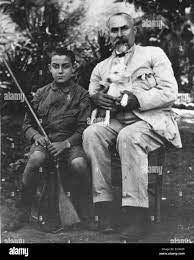Descent into the Land of Armatoles
How long before a middle ground of criminal armies vie for control of America?
Many of the saints of history seem less admirable up close. Of course, Americans have been at this for years, with historians tearing down the Founding Fathers. All had flaws. All rose above them.
But take the liberator of Latin America, Simon Bolivar. Born on a slave plantation, Bolivar’s parents died when he was young; he then went to Europe with a tutor, married a woman older than him at 18 (she died two years later); and by age 20 he was a widower and an inveterate womanizer. Though he met true men of liberationist theology, including William Wilberforce, he absorbed less of actual reform ideas and more of the verbiage of manipulation. He headed back to his homeland, hooking up with the independence-minded insurgents under Francisco de Miranda.
This Zalensky-like British-paid troublemaker had managed a Venezuelan Declaration of Independence from Spain. And, Zalensky-like, once independence was declared, Miranda beheaded a dozen supporters of the Spanish King and put their heads in cages at the entrance to Caracas. (I’m sure the little sign, “Caracas, Population 2000” was appropriately crossed out: “Caracas, Population 1988”).
Bolivar learned the revolutionary trade from Miranda, serving as his military assistant. Both sides, royalist and insurrecto, drenched themselves in blood and atrocities. Bolivar was right there with them (of course, without the green screen!) He hated the Spanish more than he loved liberty, for certain. He referred to the arrival of Spain to the New World as “the ferocious Spaniard vomited on the coast of Columbia.”
When a Spanish-backed Canarian named Monteverde defeated Miranda’s forces in 1812, the ex-caudillo was permitted to ride into the sunset. Temporary exile was common then (perhaps it should be brought back?) Bolivar changed sides and delivered Miranda to the Spanish where he died in a prison. Spain, however, did not thank Bolivar. It confiscated his lands. At that moment, “The Liberator” became for the time being just another warlord.
With only 500 men, he issued a manifesto denouncing elections and the current system of government, implying that the most ruthless dictator was the one destined to rule. Like other warlords he embraced looting and vicious methods, as did the Spanish—-one Spanish commander paid a peso for every ear of an insurgent brought to him. His men wore them on their hats. Lenin-like, one insurgent manifesto promised a commission in the rebel army for anyone bringing 20 Spanish heads. You could be a captain for 50 heads. It ain’t bitcoin, but it appeared to work.
Bolivar never quite got to the Idi Amin level, but only because he thought it counter productive. He pronounced the death sentence on any Europeans who did not aid the army of liberation. He issued the “Manifesto to the Nations of the World on the War to the Death” in 1814, promptly using its language to execute 1,000 prisoners.
Then, he grew despondent. Even as he was winning, the climate had changed. He even indirectly praised the Spanish: “We are living in terrible days. Blood flows . . . . Three centuries of culture, of enlightenment and of industry have vanished.” Er, dude, you did that, ya know? When he abandoned Caracas, he carted off nearly 28,000 ounces of silver from churches. Perhaps one of the few times he knew what he was saying came when he told his friend, “Democracy on my lips and aristocracy here.” He put his hand over his heart. He spent the next 16 years struggling to unite Venezuela and Columbia, swinging between democratic and dictatorial sentiments before dying in exile in 1830.
What is most intriguing is that half a world away, in Greece, like the Spanish the Ottoman Empire was coming apart. And, as in Bolivar’s world, paramilitary groups known as armatoles operated as the only effective government. As in Latin America, the distinctions between “law-abiding” and “criminal” had been badly blurred. A similar situation was taking root in Sicily and southern Italy. Where no official, legitimate government was recognized, law was a flexible concept. In none of these places—-Latin America, Greece, Italy, or even Spain itself for a considerable period—-was there a government that the majority of inhabitants viewed as a legitimate central authority.
Consider Spain, which from 1808 to 1826 had 51 ministers of war, 46 prime ministers, and 40 finance minister. The average stay for a prime minster was just over four months. They scarcely lasted longer than spring training. Instability such as that destabilizes everything: even the former colony of Mexico had its newly independent government overthrown twice in military coups in 18 months, followed by two more coups (one civil, then another military) within the first decade of independence.
And what does that have to do with us, Schweikart? The message seems ominous, no? A destabilized and destabilizing society that cannot agree on legitimate government—-and worse, whose government acts in all forms and manners as if it were indeed illegitimate—-tends toward chaos and warlords. Average people not accustomed to combat, soon willingly align behind anyone who can ensure their safety, from the Guardian Angels to more muscular patriot militias. As both Spain and the Ottomans learned, even if stability is restored, trust in their government is not. And the recent “let them eat cake” response to the East Palestine toxic mushroom cloud in Ohio by the Rutabaga’s regime, which is Caligula-like simultaneously evil and incompetent, is the type of moment that often severs the final threads of legitimacy.
Larry Schweikart
Rock drummer/Film maker/NYTimes #1 bestselling author
For even more truth-based current events, politics, and history content + resources, check out my VIP membership below
https://www.wildworldofhistory.com/vip
And if you don’t want to spend that much money, “Buy Larry a Coffee” here: http://buymeacoffee.com/larrys





